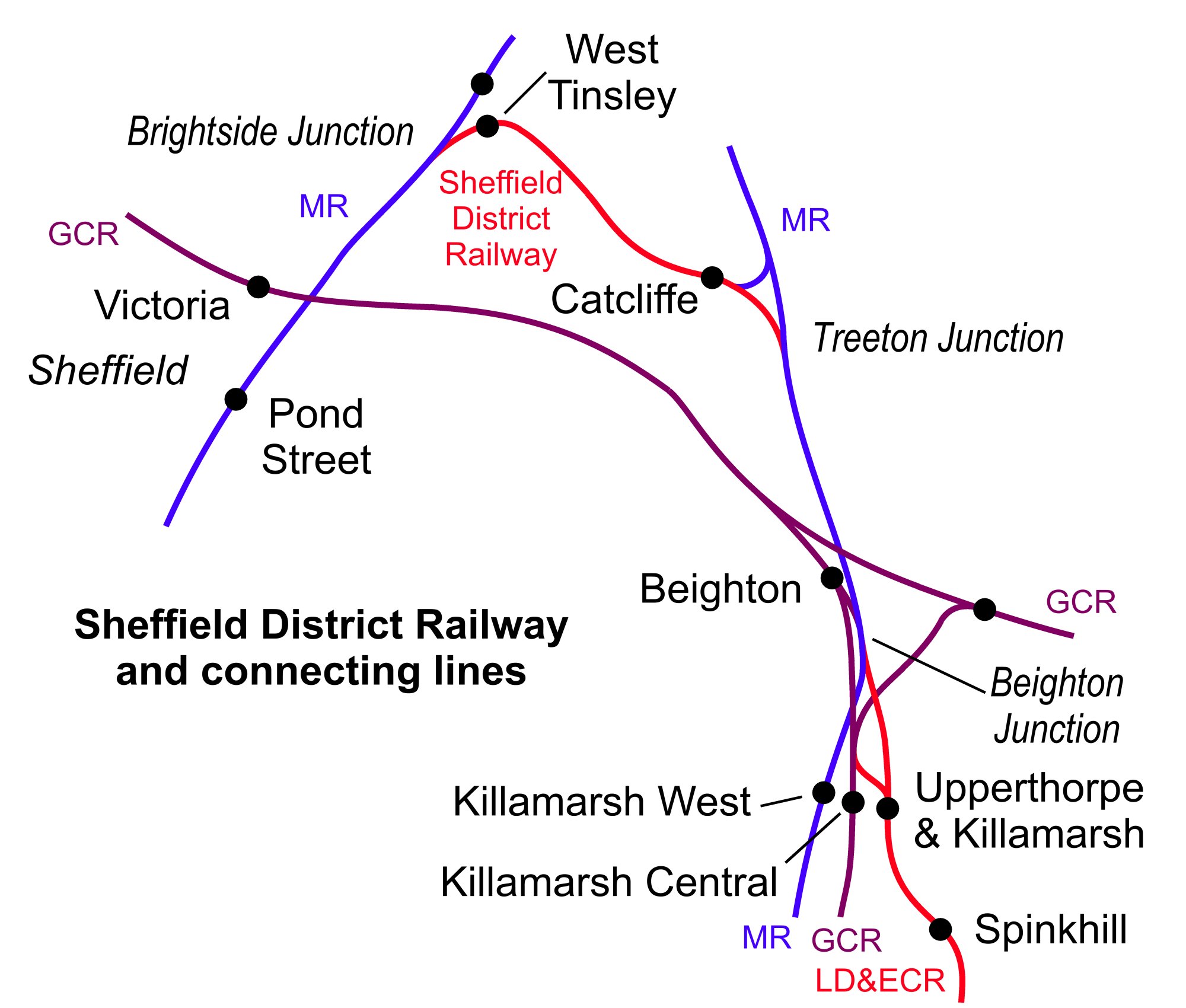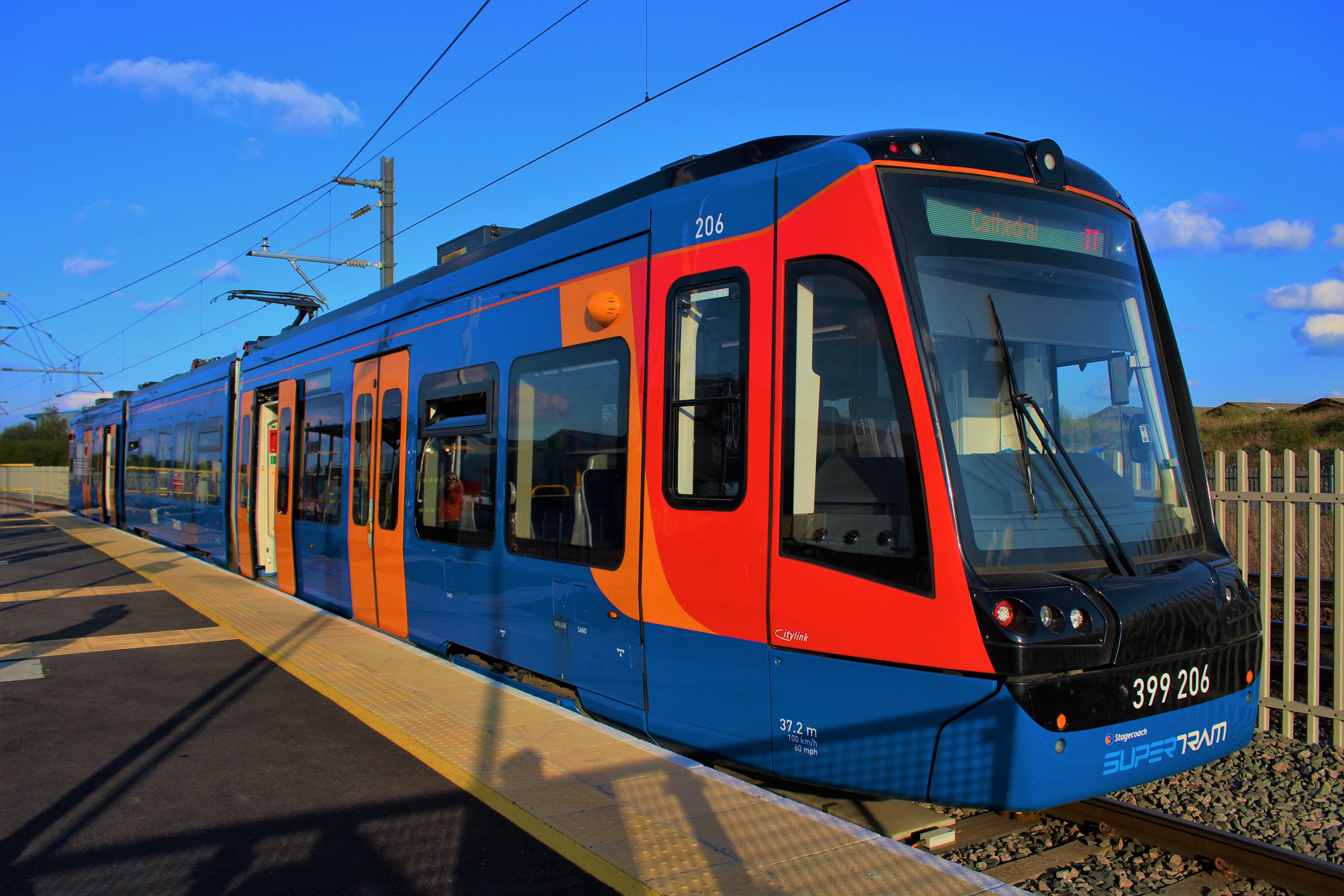|
Tinsley Railway Station
Tinsley railway station was a railway station in Sheffield, South Yorkshire, England, opened in March 1869. This station was designed by the company architect John Holloway Sanders. The station served the growing community of Tinsley and the workers at the nearby steelworks which had moved to or had been founded in the lower Don Valley following major changes in manufacturing methods in the mid - late 19th century. The station, opened by the South Yorkshire Railway, was built on the line between Sheffield Victoria and Barnsley and became a junction station with the opening of the line from Tinsley Junction (later Tinsley South Junction) to the original Rotherham station by the Manchester, Sheffield and Lincolnshire Railway. The station was located by the main Sheffield to Rotherham road in Tinsley, now on the Sheffield side of M1, Junction 34 in Tinsley. The station had two platforms, flanking the running lines, and was surrounded by sidings belonging to steel works, in ... [...More Info...] [...Related Items...] OR: [Wikipedia] [Google] [Baidu] |
Tinsley, South Yorkshire
Tinsley is a suburb of north-eastern Sheffield, South Yorkshire, England; it falls within the Darnall ward of the city. The area is associated with: * The former Tinsley Marshalling Yard, which was used between 1965 and 1998 to separate railway wagons from incoming freight trains and add them to new trains. * The former Tinsley railway maintenance depot between 1964 and 1998; at its peak, 200 locomotives were allocated here. * The former Tinsley Towers. * Tinsley Viaduct, which carries the M1 motorway across the Don Valley. History The name of the suburb derives from the Old English ''Tingas-Leah'', which means 'Field of Council', cognate with "thing (assembly)" and "lea", a dialectal word for "meadow". It is mentioned as 'Tirneslawe' or 'Tineslawe' in the Domesday Book of 1086 when it was in the possession of Roger de Busli. The chapel of St Lawrence, Tinsley was built in 1877 on the site of an ancient (possibly of Anglo-Saxon origin) chapel. Wood, Michael (2001). Tinsley ... [...More Info...] [...Related Items...] OR: [Wikipedia] [Google] [Baidu] |
Railway Platform
A railway platform is an area alongside a railway track providing convenient access to trains. Almost all stations have some form of platform, with larger stations having multiple platforms. The world's longest station platform is at Hubbali Junction in India at .Gorakhpur gets world's largest railway platform ''The Times of India'' The in the United States, at the other extreme, has a platform which is only long enough for a single bench. Among some United States train conductors the word "platform" has entered [...More Info...] [...Related Items...] OR: [Wikipedia] [Google] [Baidu] |
Railway Stations In Great Britain Closed In 1951
Rail transport (also known as train transport) is a means of transport that transfers passengers and goods on wheeled vehicles running on rails, which are incorporated in tracks. In contrast to road transport, where the vehicles run on a prepared flat surface, rail vehicles (rolling stock) are directionally guided by the tracks on which they run. Tracks usually consist of steel rails, installed on sleepers (ties) set in ballast, on which the rolling stock, usually fitted with metal wheels, moves. Other variations are also possible, such as "slab track", in which the rails are fastened to a concrete foundation resting on a prepared subsurface. Rolling stock in a rail transport system generally encounters lower frictional resistance than rubber-tyred road vehicles, so passenger and freight cars (carriages and wagons) can be coupled into longer trains. The operation is carried out by a railway company, providing transport between train stations or freight customer facilit ... [...More Info...] [...Related Items...] OR: [Wikipedia] [Google] [Baidu] |
Railway Stations In Great Britain Opened In 1869
Rail transport (also known as train transport) is a means of transport that transfers passengers and goods on wheeled vehicles running on rails, which are incorporated in tracks. In contrast to road transport, where the vehicles run on a prepared flat surface, rail vehicles (rolling stock) are directionally guided by the tracks on which they run. Tracks usually consist of steel rails, installed on sleepers (ties) set in ballast, on which the rolling stock, usually fitted with metal wheels, moves. Other variations are also possible, such as "slab track", in which the rails are fastened to a concrete foundation resting on a prepared subsurface. Rolling stock in a rail transport system generally encounters lower frictional resistance than rubber-tyred road vehicles, so passenger and freight cars (carriages and wagons) can be coupled into longer trains. The operation is carried out by a railway company, providing transport between train stations or freight customer faciliti ... [...More Info...] [...Related Items...] OR: [Wikipedia] [Google] [Baidu] |
Former Great Central Railway Stations
A former is an object, such as a template, gauge or cutting die, which is used to form something such as a boat's hull. Typically, a former gives shape to a structure that may have complex curvature. A former may become an integral part of the finished structure, as in an aircraft fuselage, or it may be removable, being using in the construction process and then discarded or re-used. Aircraft formers Formers are used in the construction of aircraft fuselage, of which a typical fuselage has a series from the nose to the empennage, typically perpendicular to the longitudinal axis of the aircraft. The primary purpose of formers is to establish the shape of the fuselage and reduce the column length of stringers to prevent instability. Formers are typically attached to longerons, which support the skin of the aircraft. The "former-and-longeron" technique (also called stations and stringers) was adopted from boat construction, and was typical of light aircraft built until the ad ... [...More Info...] [...Related Items...] OR: [Wikipedia] [Google] [Baidu] |
Sheffield Victoria-Doncaster Line
Sheffield is a city in South Yorkshire, England, whose name derives from the River Sheaf which runs through it. The city serves as the administrative centre of the City of Sheffield. It is historically part of the West Riding of Yorkshire and some of its southern suburbs were transferred from Derbyshire to the city council. It is the largest settlement in South Yorkshire. The city is in the eastern foothills of the Pennines and the valleys of the River Don with its four tributaries: the Loxley, the Porter Brook, the Rivelin and the Sheaf. Sixty-one per cent of Sheffield's entire area is green space and a third of the city lies within the Peak District national park. There are more than 250 parks, woodlands and gardens in the city, which is estimated to contain around 4.5 million trees. The city is south of Leeds, east of Manchester, and north of Nottingham. Sheffield played a crucial role in the Industrial Revolution, with many significant inventions and technologi ... [...More Info...] [...Related Items...] OR: [Wikipedia] [Google] [Baidu] |
Eastern Region Of British Railways
The Eastern Region was a region of British Railways from 1948, whose operating area could be identified from the dark blue signs and colour schemes that adorned its station and other railway buildings. Together with the North Eastern Region (which it absorbed in 1967), it covered most lines of the former London and North Eastern Railway, except in Scotland. By 1988 the Eastern Region had been divided again into the Eastern Region and the new Anglia Region, with the boundary points being between and , and between and . The region ceased to be an operating unit in its own right in the 1980s and was wound up at the end of 1992. History The region was formed in at nationalisation in 1948, mostly out of the former Great Northern, Great Eastern and Great Central lines that were merged into the LNER in 1923. Of all the "Big Four" pre-nationalisation railway companies, the LNER was most in need of significant investment. In the immediate post-war period there was a need to rebuild ... [...More Info...] [...Related Items...] OR: [Wikipedia] [Google] [Baidu] |
Meadow Hall And Wincobank Railway Station
Meadowhall and Wincobank railway station—also known in the 19th century as Meadow Hall at the time of the Meadow Hall Iron Works—was a railway station on the South Yorkshire Railway near Sheffield, England. History and description The station was on the Barnsley to Sheffield branch of the South Yorkshire Railway, and was the last station on the southern end of the line before the junction with the Midland Railway's Sheffield and Rotherham Railway. It served the communities of Brightside, Wincobank and Blackburn. This southern connection closed in August 1864 when the line to Woodburn Junction opened, and a passenger service was inaugurated between Sheffield Victoria and Barnsley station. It was opened as Meadow Hall station in May 1868 and consisted of two platforms flanking the railway. The main station building alongside Blackburn Road remains and is in good condition. It was renamed as Meadow Hall and Wincobank in July 1899, and kept the name until the station cl ... [...More Info...] [...Related Items...] OR: [Wikipedia] [Google] [Baidu] |
Broughton Lane Railway Station
Broughton Lane railway station was a railway station in Sheffield, South Yorkshire, England. The station served the communities of Darnall, Attercliffe and Carbrook and was one of those opened on 1 August 1864 with the South Yorkshire Railway's extension south from Tinsley Junction to Woodburn Junction where it met the Manchester, Sheffield and Lincolnshire Railway (MS&LR). The day the line was opened the SYR became part of the MS&LR. This link allowed the MS&LR access to Barnsley and Rotherham from Sheffield Victoria. The station, with its main access by steps from Broughton Lane bridge, possessed two flanking platforms although was surrounded by sidings. The station closed on 3 April 1956 and there are now no signs of it ever existing. In the 1960s a new line was built from near Broughton Lane into the newly opened Tinsley Marshalling Yard and shortly afterwards this was electrified. The site of the station is below the new Greenland Road viaduct over the line and canal n ... [...More Info...] [...Related Items...] OR: [Wikipedia] [Google] [Baidu] |
West Tinsley Railway Station
West Tinsley railway station is a former railway station in Sheffield, South Yorkshire, England. History The station served the communities of Tinsley and Carbrook and was situated on the Sheffield District Railway between Brightside Junction and Tinsley Yard, immediately adjacent to Sheffield Road, Tinsley. It opened on 30 September 1900 as "Tinsley Road", but was renamed "West Tinsley" by the GCR on 1 July 1907. It closed on 11 September 1939. It was briefly reopened from 6 October 1946 to 17 March 1947. The station had two wooden platforms each with wooden buildings very similar to Catcliffe, this being to reduce weight as the station was situated on top of an embankment which carried the line across the Don Valley from Brightside to Catcliffe. The station was finally closed in 1947 but it was not until the late 1960s that the buildings were demolished. Former passenger services There never was a Sunday service from West Tinsley. In 1922 three passenger services ... [...More Info...] [...Related Items...] OR: [Wikipedia] [Google] [Baidu] |
Sheffield Supertram
The Sheffield Supertram is a tram and tram-train network covering Sheffield and Rotherham in South Yorkshire, England. The infrastructure is owned by the South Yorkshire Passenger Transport Executive (SYPTE), with Stagecoach responsible for the operation and maintenance of rolling stock under a concession until 2024, under the brand name Stagecoach Supertram. Interest in building a modern tram system for Sheffield had mounted during the 1980s. After detailed planning by SYPTE, the Supertram proposal was approved by Act of Parliament#United Kingdom Parliament, Act of Parliament in 1991. Construction of the network, incorporating several existing heavy rail sections as well as new track, was carried out in sections, allowing revenue services to start during 1994. Early operations, hindered by a complex ticketing system and the initially small coverage area, had disappointing ridership figures. [...More Info...] [...Related Items...] OR: [Wikipedia] [Google] [Baidu] |






